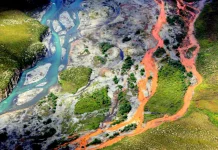Just off the coast of Okinawa in southwestern Japan, a large reservoir is encasing massive amounts of an unknown gas in an area where the Earth’s crust is being pulled apart.
New research suggests the reservoir may hold the potential for either an untapped energy resource or a greenhouse gas threat.

Methane and carbon dioxide can become trapped in sub-seafloor pockets during a process called rifting, whereby the crust pulls apart due to thermal activity as hot magma seeps from nearby areas.
As the two gases escape from magma or are produced by interactions between microbial organisms and organic-rich sediment that meets with water, they can become trapped by impermeable sediment like clay.
Methane or CO2?
An analysis of the data suggests that the reservoir may be capped by methane hydrate, or methane-containing ice.
If the reservoir is filled with methane, the researchers write that it could serve as a potential for energy. Japan became the first to extract methane from offshore methane hydrate deposits in 2013 and the US Department of Energy has since made scientific endeavors surrounding gas hydrates a priority for potential recoverable resources.
Alternatively, if the reservoir houses carbon dioxide (or methane for that matter), then it poses the potential for a greenhouse gas threat. Atmospheric carbon is a contributing cause to global climate change and, according to a newly released analysis by NOAA, carbon levels are higher than at any point in at least the past 800,000 years.
“While many people focus on greenhouse gases made by humans, a huge variety of natural sources also exist,” said study author Takeshi Tsuji, from Kyushu University. “Large-scale gas reservoirs along a rifting axis may represent another source of greenhouse gases that we need to keep our eyes on. Or, they could turn out to be a significant natural resource.“
“Zones like the one we investigate are not uncommon along rifts, so I expect that similar reservoirs may exist elsewhere in the Okinawa Trough as well as other sediment-covered continental back-arc basins around the world,” explained Tsuji, adding that other undiscovered reservoirs could be lurking deep below the surface of the ocean all around the world.
The Okinawa Trough is a seabed feature of the East China Sea and developed where the Philippine Sea Plate is subducting under the Eurasia Plate.












